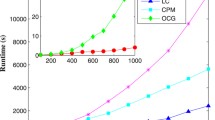Abstract
In order to find overlapping community structure of complex networks, many researchers make endeavours. Here, we first discuss some existing functions proposed for measuring the quality of overlapping community structure. Second, we propose a novel algorithm called fuzzy detection for overlapping community detection. Our new method benefits from an existing partition detection technique and aims at identifying modular overlaps. A modular overlap is a group of overlapping nodes. Therefore, the overlaps shared by several communities are possibly grouped into several different modular overlaps. The results in synthetic networks and real networks demonstrate that our method can uncover and characterize meaningful overlapping nodes.
Access this chapter
Tax calculation will be finalised at checkout
Purchases are for personal use only
Similar content being viewed by others
Notes
- 1.
- 2.
We do not mark “Sunbelt2” due to the visualization, since its position is too close to “CentralFlorida” in the figure.
- 3.
In [18], the community which has size roughly 100 nodes is good.
- 4.
We compute the frequency of topic keywords by aggregating the number of units (article), i.e., if only one unite contains the topic keywords “Neurons”, the corresponding frequency is 1.
References
Albert R, Barabasi A-L (2002) Statistical mechanics of complex networks. Rev Mod Phys 74(1):47–97
Aynaud T (2011) Détection de communautés dans les réseaux dynamiques. PhD thesis, Docteur de L’université Pierre et Marie Curie
Barmpoutis RM, Murray D (2010) Networks with the smallest average distance and the largest average clustering. arXiv:1007.4031 [q-bio.MN]
Baumes J, Goldberg M, Magdon-Ismail M (2005) Efficient identification of overlapping communities. In: Intelligence and security informatics, proceedings, vol 3495, pp 27–36
Bengtsson M, Roivainen P (1995) Using the potts glass for solving the clustering problem. Int J Neural Syst 6(2):119–132
Blondel VD, Guillaume JL, Lambiotte R, Lefebvre E (2008) Fast unfolding of communities in large networks. J Stat Mech Theory Exp 2008(10):P10008. doi:10.1088/1742-5468/2008/10/p10008
Evans TS, Lambiotte R (2009) Line graphs, link partitions, and overlapping communities. Phys Rev E 80(1):016105
Gfeller D, Chappelier J-C, De Los Rios P (2005) Finding instabilities in the community structure of complex networks. Phys Rev E, Stat Nonlinear Soft Matter Phys 72(5):056135
Girvan M, Newman MEJ (2002) Community structure in social and biological networks. Proc Natl Acad Sci USA 99:7821–7826
Grauwin S, Beslon G, Fleury E, Franceschelli S, Robardet C, Rouquier J-B, Jensen P (2012) Complex systems science: dreams of universality, interdisciplinarity reality. J Am Soc Inf Sci Technol 63(7):1327–1338
Hugot JP, Chamaillard M, Zouali H, Lesage S, Cézard JP, Belaiche J, Almer S, Tysk C, O’Morain CA, Gassull M, Binder V, Finkel Y, Cortot A, Modigliani R, Laurent-Puig P, Gower-Rousseau C, Macry J, Colombel JF, Sahbatou M, Thomas G (2001) Association of nod2 leucine-rich repeat variants with susceptibility to Crohn’s disease. Nature 411(6837):599–603
Kessler MM (1963) Bibliographic coupling between scientific papers. Am Doc 14(1):10–25
Krause AE, Frank KA, Mason DM, Ulanowicz RE, Taylor WW (2003) Compartments revealed in food-web structure. Nature 426(6964):282–285
Lancichinetti A, Fortunato S, Kertesz J (2009) Detecting the overlapping and hierarchical community structure in complex networks. New J Phys 11:033015
Lancichinetti A, Radicchi F, Ramasco JJ, Fortunato S (2010) Finding statistically significant communities in networks. PLoS ONE 6(4):e18961. doi:10.1371/journal.pone.0018961
Lancichinetti A, Radicchi F, Ramasco JJ (2009) Statistical significance of communities in networks. Phys Rev E 81:046110. arXiv:0907.3708 [physics.soc-ph]
Lee C, Reid F, McDaid A, Hurley N (2010) Detecting highly overlapping community structure by greedy clique expansion. In: Proceedings of the 4th SNA-KDD workshop. arXiv:1002.1827 [physics.data-an]
Leskovec J, Lang KJ, Dasgupta A, Mahoney MW (2009) Community structure in large networks: natural cluster sizes and the absence of large well-defined clusters. Internet Math 6(1):29–123. arXiv:0810.1355
Limbergen JV, Russell RK, Nimmo ER, Torkvist L, Lees CW, Drummond HE, Smith L, Anderson NH, Gillett PM, McGrogan P, Hassan K, Weaver LT, Bisset WM, Mahdi G, Arnott ID, Sjoqvist U, Lordal M, Farrington SM, Dunlop MG, Wilson DC, Satsangi J (2007) Contribution of the nod1/card4 insertion/deletion polymorphism +32656 to inflammatory bowel disease in northern Europe. Inflamm Bowel Dis 13(7):882–889
Michon F, Tummers M (2009) The dynamic interest in topics within the biomedical scientific community. PLoS ONE 4(8):e6544–08
Nepusz T, Petroczi A, Negyessy L, Bazso F (2008) Fuzzy communities and the concept of bridgeness in complex networks. Phys Rev E, Stat Nonlinear Soft Matter Phys 77(1):016107
Newman MEJ (2004) Analysis of weighted networks. Phys Rev E 70:056131
Newman MEJ (2006) Finding community structure in networks using the eigenvectors of matrices. Phys Rev E 74:036104
Pu S, Wong J, Turner B, Cho E, Wodak SJ (2009) Up-to-date catalogues of yeast protein complexes. Nucleic Acids Res 37(3):825–831
Reichardt J, Bornholdt S (2006) Statistical mechanics of community detection. Phys Rev E 74(1):016110
Sales-Pardo M, Guimera R, Moreira A, Amaral L (2007) Extracting the hierarchical organization of complex systems. Proc Natl Acad Sci USA 104(39):15224–15229
Shen HW, Cheng XQ, Guo JF (2009) Quantifying and identifying the overlapping community structure in networks. J Stat Mech Theory Exp P07042. doi:10.1088/1742-5468/2009/07/P07042
Traud A, Kelsic E, Mucha P, Porter M (2009) Community structure in online collegiate social networks. J Stat Mech Theory Exp 2009:P07042
Wang XH, Jiao LC, Wu JS (2009) Adjusting from disjoint to overlapping community detection of complex networks. Phys A, Stat Mech Appl 388(24):5045–5056
Zachary WW (1977) An information flow model for conflict and fission in small groups. J Anthropol 1(33):452–473
Author information
Authors and Affiliations
Corresponding author
Editor information
Editors and Affiliations
Rights and permissions
Copyright information
© 2013 Springer Science+Business Media Dordrecht
About this chapter
Cite this chapter
Wang, Q., Fleury, E. (2013). Overlapping Community Structure and Modular Overlaps in Complex Networks. In: Özyer, T., Erdem, Z., Rokne, J., Khoury, S. (eds) Mining Social Networks and Security Informatics. Lecture Notes in Social Networks. Springer, Dordrecht. https://doi.org/10.1007/978-94-007-6359-3_2
Download citation
DOI: https://doi.org/10.1007/978-94-007-6359-3_2
Publisher Name: Springer, Dordrecht
Print ISBN: 978-94-007-6358-6
Online ISBN: 978-94-007-6359-3
eBook Packages: Computer ScienceComputer Science (R0)




